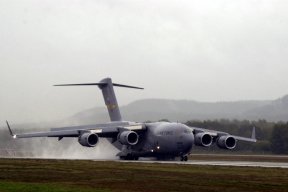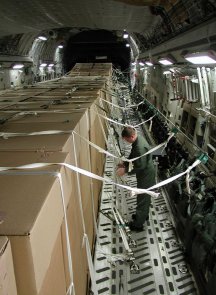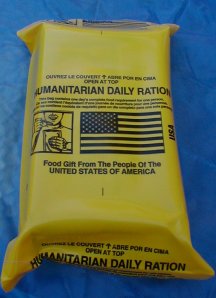They went into Afghanistan under cover of darkness. Unarmed. Flying too high to fear anything except the most sophisticated ground to air missiles. And intelligence reports told them in advance there was little to zero chance of that kind of weaponry being under their flight path. But there was always a chance. With bin Laden, you could never know for sure about anything. So for protection they let some F-15 fighter jets ride along, flanking their wings and taking out anything that did challenge them.

Allen |

Globemaster landing after mission |
Nevertheless there was little comfort that first night as Allen, with the High Altitude Air Mission Supports (HAAMS) out of Langley Air Force Base, flying over desolate, barren Afghanistan peeked down and watched gunfire, directed at the big C-17 Globemaster laden with food supplies, fall short of the target.
Allen, was one of several physiological technicians required to fly the missions to provide oxygen support to the crew delivering the

Loaded C-17 ready for takeoff |
Humanitarian Daily Rations (HDRs) to hungry Afghanis who were among the first in the country to militarily engage bin Laden's Taliban forces in the northern section of the rugged landscape.
"That first night the gunfire, that was a little unnerving to watch it fired at us," Allen explained. "For the big stuff, we had F-15 fighter escorts. If a radar site antiaircraft site locked onto us, the F-15s would take them out. We'd been briefed: 'If you stay on course there'll be nothing available to hit you.' After that it was more routine. "Plus the C-17 has certain electronic counter measures," he said.

Contents of 1-HDR contained 2 complete meals (top), bread, peanut butter, jelly, raisins, crackers, fruit bar, plastic spoon, salt, pepper, sugar, red flake pepper, an non-alcoholic wet and dry towel. H.J. Heinz company provided much of the contents on contract to military and the per package cost was $4.25. |
"The scariest thing that happened, and it happened several times, was when we'd be flying along in total blacked out conditions in the dark sky over Afghanistan and suddenly we'd be lighted up with a monster spotlight. It would sweep us from nose to tail. The first time it happened, it got our attention. We never did find out what that was all about," Allen said.
"But still, going on my first combat mission on a HAAMS job, yeah, I was a little concerned."
It was Allen and it fellow phys-techs job to make sure no one became a victim of air or altitude sickness from lack of oxygen. Some 30 phys-techs, including four from Langley, were sent to Ramstein Air Base in Germany where the HDR flights originate, for the HAAMS missions.

HDR package measured about 6x12 and weighed about 2 pounds |
The flights went in well above 30,000 feet. "Our job was to get the crew on oxygen masks for 30-minutes before arriving over the drop zone where we'd swoop down, open the rear of the aircraft and they'd have to work in a de-pressurized environment.
"By the time we were ready to drop, the loadmaster or one of the crew, yanked one strap, the pilot would nose the plane up, and the contents would roll out the rear. A piece of cake.
"Now falling from that altitude, if one of those little packages hit your donkey, it would knock him on his ass.
"But as far as I know we didn't have any causalities," Allen said. "Anytime we go above 13,000 feet, in an unpressurized environment, everyone has to be on oxygen."
The flights took 14-17 hours roundtrip and required two in flight refuelings.
One of the most disturbing things came when the crew heard news reports on TV showing that the Afghanis were collecting the HDRs, opening them and feeding them to their donkeys and camels. "To think we were spending that kind of money, risking manpower and equipment to feed donkeys, that bothers me a bit," Allen said.
The Globemasters flew 198 missions during 74 days, dropping 2.5 million HDRs; 21,000 55-pound sacks of wheat; and 42,000 blankets. The missions ended Dec. 21 after anti-Taliban forces captured Kandahar Airport. Supplies and humanitarian missions will operate from Kandahar and from ground convoys and via river traffic.
| Virginia News Source takes
this opportunity to join everyone nationwide in paying tribute to the
sacrifices, dedication, and job well done by our servicemen seeing
action overseas. VNS also wishes to express its appreciation for the
assistance of those contributing to this feature.
Photos courtesy USAF |